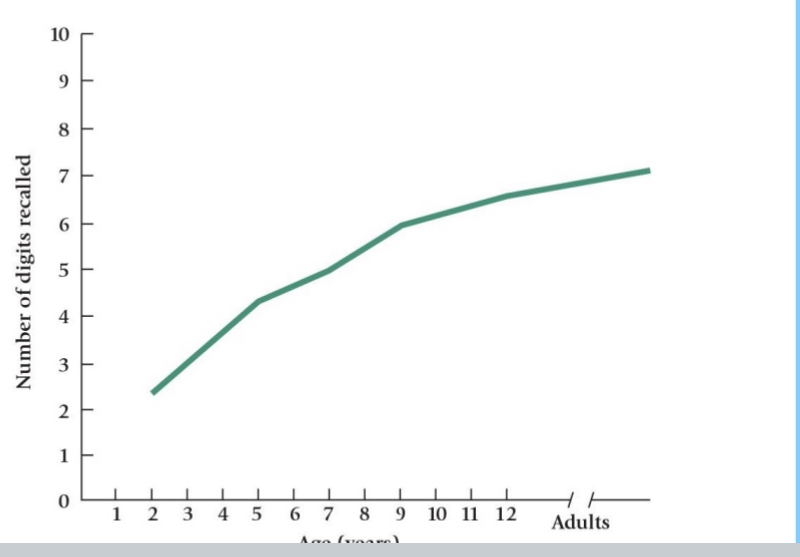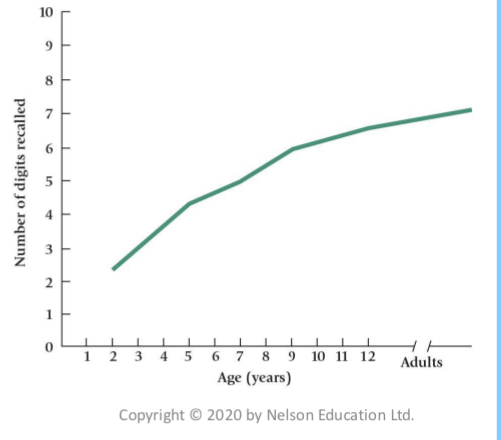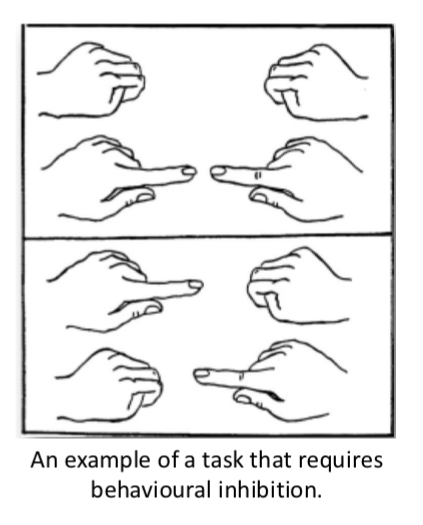Lesson 7: Cognitive development : information processing
1/53
There's no tags or description
Looks like no tags are added yet.
Name | Mastery | Learn | Test | Matching | Spaced |
|---|
No study sessions yet.
54 Terms
Clarification of Some Concepts from Week 6: Piaget’s Formal Operational Stage
Hypothetico-deductive reasoning
Inductive reasoning
Hypothetico-deductive reasoning
the ability to think hypothetically.
Deductive reasoning
(reasoning from the general to specific) is not in itself a formal operational ability (because concrete operational children can solve problems when given concrete facts).
What is unique about the formal operational stage
is the ability to think hypothetically (important for algebra and mathematics). There is development of deductive reasoning in this stage but it does not emerge in this time
Inductive reasoning
reasoning from specific observations to broad generalizations. It is the ability to “think like a scientist”; hypotheses are generated and systematically tested in experiments. This emerges in the formal operational stage.
Both Piaget and Vygotsky
noticed that children talk to themselves, but they had different viewpoints on this self talk.
Piaget referred to it as egocentric speech and believed that it was non-social in nature, and that it reflected their egocentric perspectives.
Vygotsky referred to it as private speech, and that it was self-communicative in nature; this private speech eventually turns into an inner speech that is used as a cognitive self-guidance system.
A(n) _________ is an organized pattern of thought or action that one constructs to interpret some aspect of one’s experiences.
a) Accommodation
b) Scheme
c) Adaptation
d) Stage
b) Scheme
Renee sees a kangaroo for the first time and tries to adapt to this novel stimulus by construing it as something familiar: a “doggie”. What is this process, according to Piaget’s theory?
a) Organization
b) Accommodation
c) Equilibrium
d) Assimilation
d) Assimilation → kangaroo ‘similar’ to dog
Six-year-old Akim thought all dogs were big, like his dog, until he saw his friend’s new Chihuahua. Akim now realizes that dogs come in many different sizes. What does this change in Akim’s understanding of dogs illustrate?
a) Object Permanence
b) Assimilation
c) Centration
d) Accommodation
d) Accommodation → updating schema for new information
Sylvia is an infant who is playing with a small stuffed dog when it falls and rolls under her crib. She does not seem particularly distressed, and she does not search for the lost toy. According to Piaget, what accounts for Sylvia’s behaviour in response to this event?
a) She has not yet mastered conservation.
b) She has mastered object permanence.
c) She has not yet mastered object permanence.
d) She has mastered the concept of conservation.
c) She has not yet mastered object permanence.
According to Piaget, what does egocentric speech indicate about the child?
a) It is a sign of cognitive immaturity and should be discouraged among young children so that it does not interfere with task performance.
b) It is a sign that the child is cognitively gifted.
c) It is a sign of use of language to mediate behaviour and facilitate performance of difficult tasks.
d) It is a sign of cognitive immaturity and egocentrism that characterizes preschoolers and early-grade-school children.
d) It is a sign of cognitive immaturity and egocentrism that characterizes preschoolers and early-grade-school children.
Multistore Model:
it is a type of information processing model; it depicts the flow of information in thinking.
Hardware = computer, keyboard, storage capacity (minds hardware is the nervous system, brain, sensory receptors, neural connections)
Software = programs we upload to it, computer uses to store and manipulate info it has (minds software is the rules and strategies and mental processes that we use to make sense of info we receive, to store and interpret it)
Information flows through three processing unit in multi-store model
Sensory store
Short term store (STS)
Long term store (LTS)
All part of central executive operating system
Sensory Store:
holds raw sensory information from senses.
Information is lost in 0.5-3 seconds, unless attended to.
Short-Term Store (STS):
also called “working memory”.
Can hold 5-9 pieces of information.
Unrehearsed information is lost in 10-15 seconds.
Phone number from yellow page to phone on wall
Long-Term Store (LTS):
examined information stored for future use.
Information Flow & the Multistore Model Diagram

As humans, we actively influence the information in the multistore model through cognitive processes, such as:
Executive function
Attention
Inhibitory control
Set shifting
Executive Function:
planning and executing strategies on the information gathered from LTS.
Attention:
process of selecting stimuli to detect or work on.
Inhibitory Control:
intentionally choosing to not attend to information.
Set-Shifting:
moving from one strategy to another.
_______ memory holds large amounts of information for a very brief period of time
a) Sensory
b) Short Term
c) Working
d) Long Term
a) Sensory
Overview of Developmental Differences in Information Processing
Working memory capacity improves with age.
Better “hardware”.
Strategies improve with age.
Better “software”.
Sustained attention and more selective attention with age.
Improved executive function & metacognition with age.
Capacity in an information-processing system can refer to
the amount of space available to store information, how long information can be stored, or how quickly information can be processed.
5 yr old has less capacity than 18 yr old so they remember a shorter list of numbers
Processing capacity predicts performance in many cognitive tasks we perform every day
takes 5 yr old longer to solve 2+2
How does the capacity of working memory (aka short-term store; STS) change with age?
There are changes in:
Memory span (i.e., the amount of information that can be held in the STS; measured through digit span tasks)
The speed at which information is processed (measured through reaction time tasks).
Domain-specific processing efficiency (specialized learning mechanisms for different domains/areas)
To test the capacity of the STS, memory span tests have been used.
E.g., Digit Span Task
Given series of numbers that you have to repeat them back. If you were successful, the person in charge of experiment will increase the amount of numbers they give you
Up until about the age of 7 to 9 years old, children’s memory span is equal to their age (in years).
A 2 yr old can hold 2 pieces of information. 3 yr old can hold 3 pieces of information etc….
With development, individuals are able to use their memory span in more difficult tasks.

Chi (1978) conducted a study that illustrated that expertise was influential upon information processing capacity in that domain.
Participants completed 2 tasks: 1) digit span task and 2) a task that assessed memory of chess pieces on a board.
Graduate students’ performance was compared to 10-year-old “chess” experts’ performance.
Results illustrate domain-specific processing efficiency (specialized learning mechanisms for different domains/areas).
Amount of numbers that 10 yr olds could remember was less than amount of numbers adults could remember → we know that, memory span increases with age
Children could recall the chess pieces better (because thats their expertise) than the adults. But just because children were experts in chess, this ability did not translate to digit span task
Being an expert in the field you can process info more efficiently resulting in more room for working memory
If you’ve never seen a chess board, you have to use brain power to figure out what each piece does, and where did they go. Where someone who is an expert in chess doesn’t use to much brain power on confusion on the shape of each chess piece.

In sum, the working memory capacity may increase with age due to:
Increases in memory span.
More efficient processing and increased processing speed.
Expertise/ increases in children’s knowledge bases.
Maturational developments (e.g., increased myelinization).
Strategies:
goal-directed and deliberately implemented mental operations used to facilitate task performance.
Strategic Memory
processes involved as one consciously attempts to retain or retrieve information.
Memory Strategies or Mnemonics:
effortful techniques used to improve memory.
Examples: rehearsal, semantic organization, and elaboration.
The ability to use strategies improves with age.
Rehearsal
Repeating information in head so you don’t forget it
At age of 7 or 8 children spontaneously use rehearsal to aid in memory, younger children don’t use this skill
Semantic organization
Organize words into categories, group similar meaning / characteristic words together
Error in recall: add words that weren’t apart of the original list to the categories simply because they fit.
Ex. I have a category for furniture so I add chair, but that word was not originally given to me
elaboration
Strategy remember something by adding something to it
Used better in adolescence because they have bigger knowledge base and can do hypothetical thinking better
ex. Word for duck is Spanish is pato, to remember this imagine duck in a pot

Last class, we watched a video of Phil from ‘Modern Family’ trying to remember a client’s name. Phil said, “He was wearing a shirt with a fish on it. Where do fish live? The ocean. What else lives in the ocean? Coral…Hello CARL!” What type of memory strategy is Phil using?
a) Organization
b) Elaboration
c) Rehearsal
d) Exaggeration
e) Two of the above.
b) Elaboration

Last class, we discussed this graph. What conclusions can be drawn from this graph?
a) The number of digits that individuals can count up to is ~equal to their age until the age of 7- to 9-years-old.
b) Enhances in memory span across development suggests improvements in short-term memory capacity.
c) Enhances in memory span across development suggests improvements in sensory store capacity.
d) The number of digits that individuals can count forward and backward is ~ equal to their age in years until adulthood.
b) Enhances in memory span across development suggests improvements in short-term memory capacity.
Which of the following key terms are incorrectly matched with its definition?
a) Sensory Store: holds raw sensory information from the senses.
b) Set-Shifting: refers to moving from one strategy to another.
c) Domain-Specificity: refers to how improvements in one domain specifically relates to improvements in another domain.
d) Memory Strategies: techniques that are easily and effortlessly applied to improve memory.
e) Two of these options are incorrectly matched.
e) Two of these options are incorrectly matched.
c) Domain-Specificity: refers to how improvements in one domain specifically relates to improvements in another domain. → expertise in one domain is not transferable to another. Remember the chess players
d) Memory Strategies: techniques that are easily and effortlessly applied to improve memory. → effortful not effortless
Production Deficiency:
failure to spontaneously generate and use known strategies that could improve learning and memory.
Utilization Deficiency:
when children experience little or no benefit when they use a new strategy.
Information theorists suggest it may be due to:
Too much mental effort required by new strategy.
Inability to monitor cognitive processes
Repeating the word “dog” is not helpful to remember where the dog is
Siegler’s Adaptive Strategy Choice Model:
Describes how strategies change over time.
Proposed that multiple strategies exist, and they compete with one another for use.
Organization, rehearsal, elaboration etc..
With age, children can use more sophisticated strategies.
Younger child more likely to use rehearsal than elaboration
For new problems, children rely on older fallback strategies that were more successful in the past→ rehearsal

The adaptive strategy choice model by Siegler et al. suggests that:
a) Strategies develop in a step-like manner.
b) Over time, more sophisticated strategies triumph over simpler strategies.
c) Young children cannot be strategic.
d) Multiple strategies exist side-by-side in a child’s mind.
e) All of the above
d) Multiple strategies exist side-by-side in a child’s mind.
Attention Span:
capacity for sustaining attention to a particular stimulus or activity.
Increases with age, partly due to increasing myelinization of the central nervous system and reticular system.
Reticular Formation:
area of the brain that activates the organism and is thought to be important in regulating attention.
Development of planful attentional strategies:
With age, attention becomes more planful and selective.
Sustained Attention & More Selective Attention with Age
If a preschooler was asked to determine if the two houses were the same, they would likely incorrectly state that they were the same.
Whereas a school-aged child would use a more systematic way of comparing the two images, and would come to the conclusion that they are not the same.
With age, the gathering of information is more systematic and illustrates planful attentional strategies
Planful strategies : if asked to find differences between 2 photos, you might look at one isolated location of photo 1 and then look at that same spot on photo 2
Lines on the photos is where the child’s eyes would trace on the photo to compare them
Younger child not looking at entire picture, jumping between different sections, not systematic comparing

Selective attention:
capacity to focus on task-relevant aspects of experience while ignoring irrelevant or distracting information.
Engaging in selective attention is very difficult for younger children; they display little ability to do so.
Older children are much better than younger ones at concentrating on relevant information and filtering out extraneous input that may interfere with task performance
Cognitive Inhibition
dismissing irrelevant information.
Selective attention vs cognitive inhibition
Selective attention
is the ability to focus on relevant information while ignoring distractions
It allows us to filter out distractions and focus on what's important, leading to better performance in various cognitive tasks, including learning, problem-solving, and decision-making
Focus on exam and ignore the monkey that walked in room
cognitive inhibition
is the ability to suppress irrelevant thoughts or actions.
Inhibitory control is essential for self-regulation, allowing us to manage our impulses, stay focused on tasks, and adapt to changing situations
Inhibition:
the ability to prevent ourselves from executing some cognitive or behavioural response.
Deficits in inhibition are seen in infancy and childhood (e.g., Piaget’s A-not-B task).
Neurological maturation of the frontal lobes and cerebral cortex contribute to the development of inhibitory control.
There is a substantial improvement in performance of inhibitory control between the ages of 4- to 7-years-old.

Improved Executive Function & Metacognition with Age
Cognitive processes improve through childhood, into adolescence and into the early 20s.
Children’s awareness of the distinction between conscious and unconscious thought develops gradually.
Most infant thoughts are implicit.
Implicit cognition:
thought that occurs without awareness that one is thinking; is unconscious.
Ex. Don’t think before reaching for bottle of water or breathing
Explicit cognition:
thinking and thought processes of which we are consciously aware; is conscious.
Ex. Think about how hair looks
Metacognition:
knowledge about cognition and about the regulation of cognitive activities